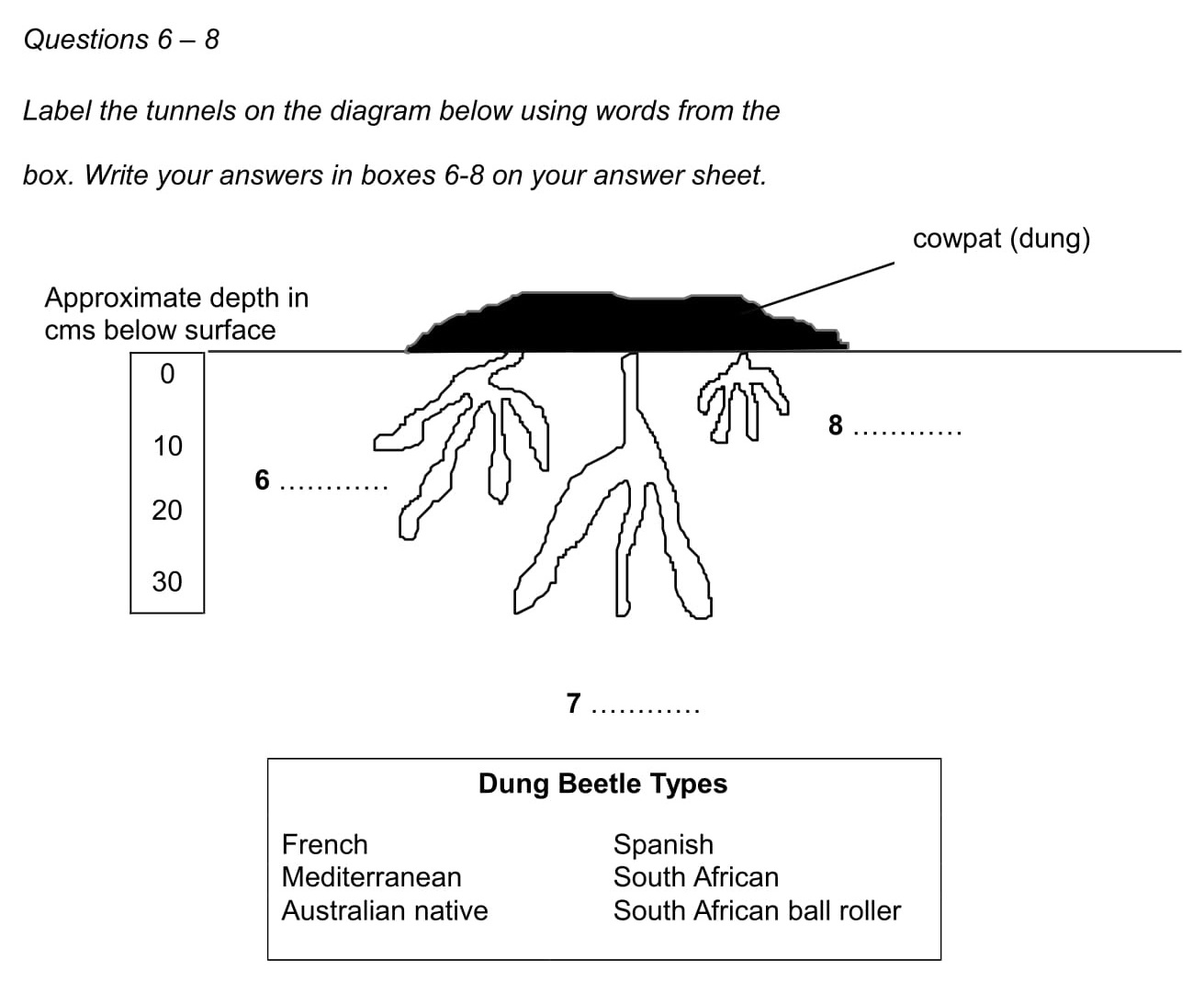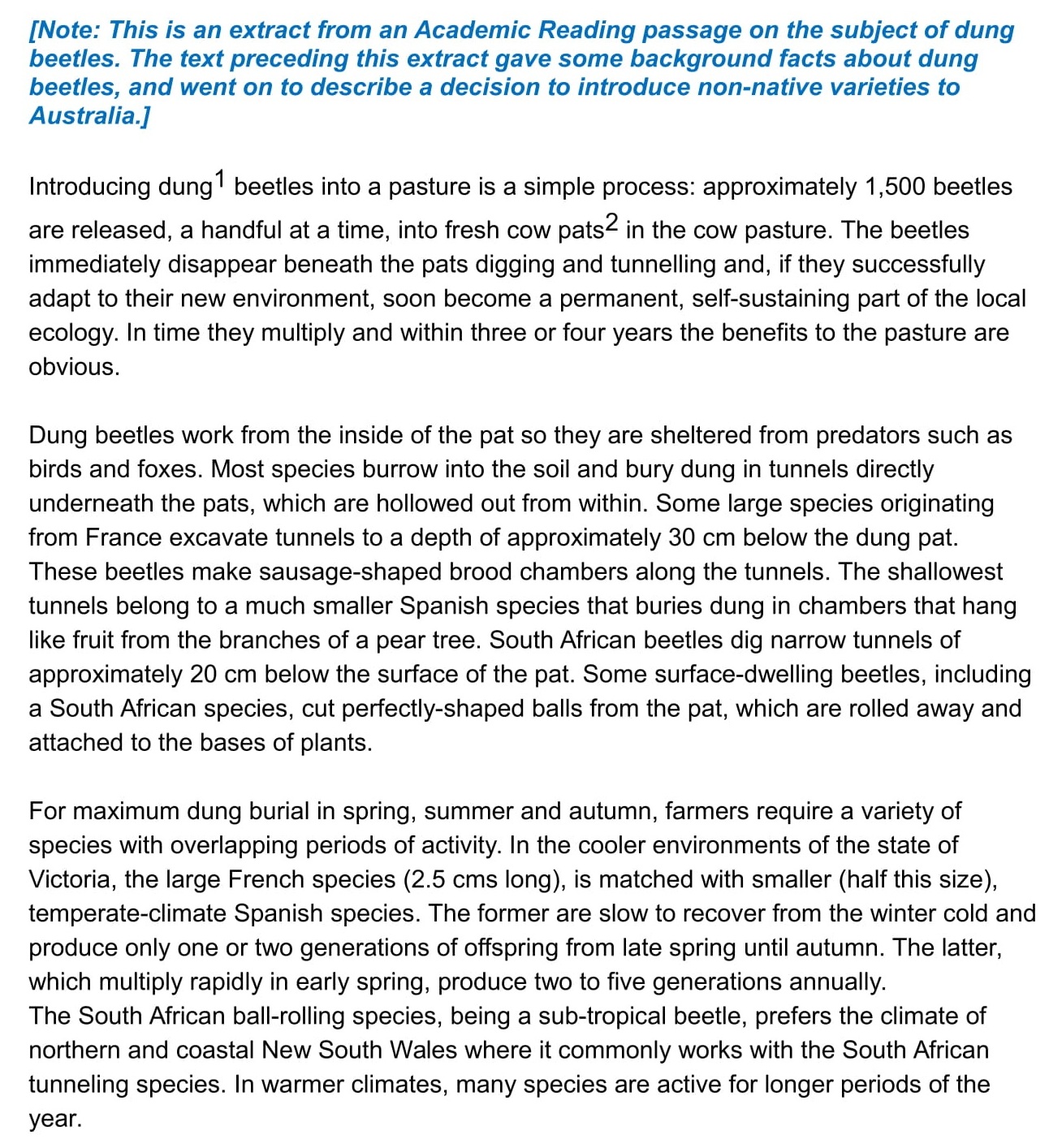After Reading the Label Carefully, Tara Reconstitutes
IELTS Reading
Diagram Labelling Questions
Many candidates dread getting a diagram labelling question in their IELTS Reading Test because they fear that they won't sympathize the diagram, specially if it's on a technical subject.
At that place's no demand to worry equally you don't need to fully understand it. Simply utilize the information given, just as you do with every other blazon of question. I show yous how on this folio. Here's what it covers:
- Explanation of this question type
- Skills needed
- Key tips
- The strategy
- E xamples from a existent test newspaper
Explanation of this question type
- You will be given a diagram or a plan.
- You are required to label specific parts with words from the text or a word list.
The diagram will exist one of the following:
- A design or plan
- A technical drawing, east.g. a machine or invention
- A diagram of something in the natural globe
If y'all are required to select words from the text for the answers, you'll be told how many words you're immune to use for each label. For example, I WORD or NO MORE THAN TWO WORDS. Hyphenated words such as 'mother in law' count every bit one give-and-take.
If you lot use the wrong number of words, your answer will be marked wrong fifty-fifty if the data you lot give is correct.
Here's an example of a set of instructions taken from a past exam paper. Nosotros'll be working on this diagram labelling task subsequently.

Source: Cambridge English Past Test Paper
This particular question includes a list of words with which to label the diagram. The information needed to characterization it correctly volition be in the text, although it may exist concealed in synonyms and paraphrasing.
Skills needed
This blazon of question tests your ability to:
- Translate a diagram
- Scan for specific information
- Identify synonyms & paraphrasing
- Read in item for meaning
Fundamental tips
1) Diagram labelling questions are not equally hard every bit they may at commencement seem. If you apply the step-by-step strategy I explain below, y'all should be able to master them.
two) Don't panic if the diagram looks complicated. It won't be. A diagram is simply some other way of presenting information – a combination of language and a cartoon.
You need no prior knowledge of the subject in gild to consummate it. Remember, this is a exam of your reading skills, cypher else. Over again, just follow the strategy.
iii) Apply whatsoever piffling clues that are present in the diagram to help y'all understand it. In our diagram, for instance, nosotros have,
- Some numbers
- Some text
- One completed label
- A heading in the word list box
Each gives you of import data about the topic and will exist related to the answers in some way. I'll evidence you how to translate it below.
4) You may be given a glossary of primal words that could be unfamiliar to you. They'll exist below the text. Hither'south the glossary for this question.
Glossary
1. dung: the debris or excreta of animals
2. cowpats: debris of cows
5) Try to go a full general understanding of the diagram before you read the text.
half-dozen) Scan for keywords in the text to locate the paragraph with the respond in then read in detail to identify the words or words needed for the characterization.
7) The information in the text that contains the answers will very probable include synonyms so be on the lookout for them.
8) If you're struggling with a particular characterization, movement on. Catch the easiest marks and come dorsum to relook at the others afterwards if in that location's time left at the end.
Make an educated guess if y'all take to rather than leaving the answer blank. Yous may guess correctly and score the betoken.
If you're choosing words from a word list, it will exist easier to decide the respond when you lot've eliminated some of the other words.
The Strategy
I'll show you how to use this strategy in the example beneath only first, you need to understand it.
# 1 Read the instructions carefully. Start, find out whether yous have to label the diagram with words from the text or from a word listing.
If the words come from the text, annotation how many words you're required to write, e.g. ONE WORD or NO More than THAN Two WORDS.
# ii Briefly expect at the diagram and try to become a full general understanding of what it's showing. In that location will be clues in headings, figures and any labels already added.
# 3 Browse the text for key words. This volition identify where the answers are located.
# 4 Read the relevant section of text in particular to observe each respond.
# 5 Fill in the answer sheet and check your spelling.
Example with answers
This question is from a past IELTS Reading test paper taken from the official IELTS website, www.ielts.org. As noted above the text, only role of the text is shown for this practise question. The passage in your test will be longer.
Before checking the answers, see if you can label the diagram post-obit the steps in the strategy. I've added the diagram again to save you having to scroll up and downwards the folio.
When yous've completed the task, read my notes beneath on how I found the answers. They include lots more tips to assistance you with diagram labelling questions.

Glossary
i. dung: the droppings or excreta of animals
2. cowpats: debris of cows

Source: Cambridge English Past Examination Paper
Source: Official IELTS website ielts.org - Diagram Labelling Sample Test
Notes on how I answer the questions
1) I offset past advisedly reading the instructions to be sure that I know what I have to practice.
2) Side by side, Istudying the information on the diagram to sympathise what the diagram is well-nigh and to work out the sort of data I'll need to observe in club to label it correctly. These are the key points that I note:
- The instructions say that I accept to label three tunnels numbered 6, 7 and viii.
- Each label is a type of dung beetle from the give-and-take list.
- The just difference betwixt the tunnels is their depth which is shown by the scale 0 to xxx on the left side of the diagram.
I conclude that I will place the correct answers by finding out how deep the different types of dung beetles dig their respective tunnels.
iii) Knowing this information, I make up one's mind to scan the text for the numbers. These are actually measurements – 0 cm, 10 cm, 20 cm and thirty cm. They should be easy to find and will atomic number 82 me to the answers. I'chiliad mindful that they could be written in words and so watch out for this.
iv) I notice sentences with '20 cm' and '30 cm' in. I read them in detail.
- Some large species originating from France excavate tunnels to a depth of approximately xxx cm below the dung pat.
- Due south African beetles dig narrow tunnels of approximately 20 cm beneath the surface of the pat.
5) The first sentence conspicuously states that the dung beetle that digs tunnels 30 cm deep, comes from France.
Some large species originating from French republic excavate tunnels to a depth of approximately 30 cm below the dung pat.
I check the word list and find ' French ' (which ways 'comes from France') amongst the possible labels.
I then look at the diagram to place which label relates to the 30 cm deep tunnel. It's label seven so the reply must be 7 French .
I fill in my answer and cantankerous through 'French' in the give-and-take list.
(Knowing these words/synonyms will help you to sympathize the sentence:
- species – blazon
- originating – comes from
- excavate – dig
However, as long as you find ' thirty cm ' and know that 'French' means 'comes from France', you should exist able to get the answer.)
6) I move on to the second sentence I've identified in the text.
South African beetles dig narrow tunnels of approximately 20 cm below the surface of the pat.
The respond seems clear. It'due south the South African beetle that digs tunnels 20cm deep. I check the word list for 'Southward African' but find two different types.
Dung Beetle Types
French Spanish
Mediterranean Due south African
Australian native Due south African ball roller
I read the paragraph in detail for more than data, particularly looking out for the words 'brawl roller' or something similar.
I find the information I need in the next judgement.
S African beetles dig narrow tunnels of approximately twenty cm below the surface of the pat. Some surface-dwelling beetles, including a Due south African species, cut perfectly-shaped balls from the pat, which are rolled abroad and attached to the bases of plants .
Here I acquire that the S African brawl roller beetle attaches the balls of dung to the base of operations of plants and doesn't dig tunnels. This, so, is not the reply.
The answer must be 6 S African .
I fill in the reply, cantankerous through 'South African' in the word list and move on to the final label.
7) I at present demand to observe out which beetle digs a tunnel of about x cm. However, 'x cm' isn't mentioned in the text so I decide to scan for the remaining types of beetle (Spanish, Mediterranean and Australian native) to find the answer by a procedure of elimination.
I start by scanning for ' Spanish ' and quickly discover the following judgement in the third paragraph.
The shallowest tunnels vest to a much smaller Spanish species that buries dung in chambers that hang like fruit from the branches of a pear tree.
The word ' shallowest ', meaning, less deep than the rest, tells me that this could be the answer just I scan for the 'Mediterranean' and 'Australian native' every bit well simply to be sure. Neither type of protrude is mentioned in the text so the concluding answer must exist 8 Spanish .
Answers
6 Due south African
7 French
8 Spanish
Want to sentinel the video of this folio?
Click here.
I promise you've found these extra notes helpful. You lot are now ready to practice on your own. Make this do a part of your preparation piece of work and you'll soon feel more confident in your ability to answer diagram labelling questions in the IELTS Reading test.
Similar this folio?
Lessons On All Question Types
For more sample questions with stride-by-step instructions, see the IELTS Reading card page.
- Home ›
- IELTS Reading ›
- Diagram Labelling
-
Back To Acme
Source: https://www.ieltsjacky.com/ielts-reading-diagram-labelling.html
0 Response to "After Reading the Label Carefully, Tara Reconstitutes"
Publicar un comentario